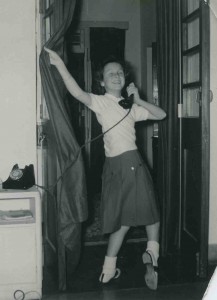India, Woodman Family »
Jana, how are you? Can you hear me?
August 9, 2012 | 1 Comment | Betsy Woodman
I was asked recently to list the most striking differences between India of the early 1960s and India today.
Oh my! Call in the pundits. For starters, then, there were about 440 million people in India; now, there are more than 1.2 billion. The cities have exploded—greater Delhi, for example, has gone from about 2.6 million to about 17 million. India is now one of the fastest-growing economies on earth. Perhaps most importantly, the communications revolution has arrived, and it has been a true revolution.
In 1960, in New Delhi, we were lucky to have good phone service. Here’s my sister Lee apparently getting some welcome news.
The country as a whole was another matter—India had seven phone lines per 100,000 people. The rural areas were essentially unserved.
I can remember only one instance in ten years when my family spoke by phone to relatives in the States, after my grandfather died, in 1958. That very expensive call took a day to go through. What with the hissing and crackling noises on the line, we might have been trying to communicate with outer space. Any comfort derived from the call was less for the words transmitted, which couldn’t be heard, than from the fact that a call had been made at all.
Now, the airwaves buzz with conversation. In May 2012, there were over 929 million mobile phone subscribers in India, with more being added at a dizzying pace.
How easily characters can communicate makes a difference in a story. Romeo and Juliet might not have had a tragic ending if the young lovers had been texting each other every two minutes. (Ro, where r u?) A communications mishap in 2012 might have to be based on battery failure or the theft of a cell phone.
In Jana Bibi’s fictional Himalayan village, people work hard to communicate. They happily greet the postman who trudges up the walk with his satchel of letters. In the second book of the series (now in the pipeline) Jana and a friend make an international phone call and they wait for hours at the Postal, Telephone, and Telegraph Office. Locally, they send notes to each other by runner—that’s why one of the characters can be a messenger boy.
A reviewer called the book a “dreamscape,” and I think that these low-tech elements are important parts of creating that atmosphere. I hope that readers will have fun dreaming along, too.






I LOVE THIS BLOG! Watson. Come here Watson…..